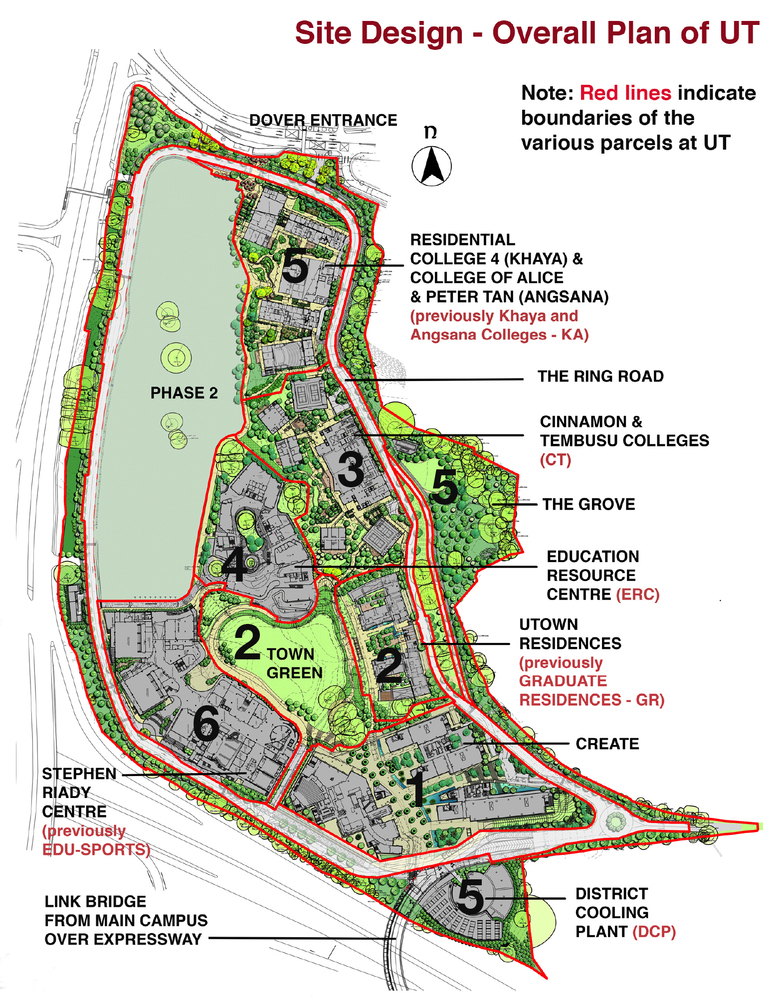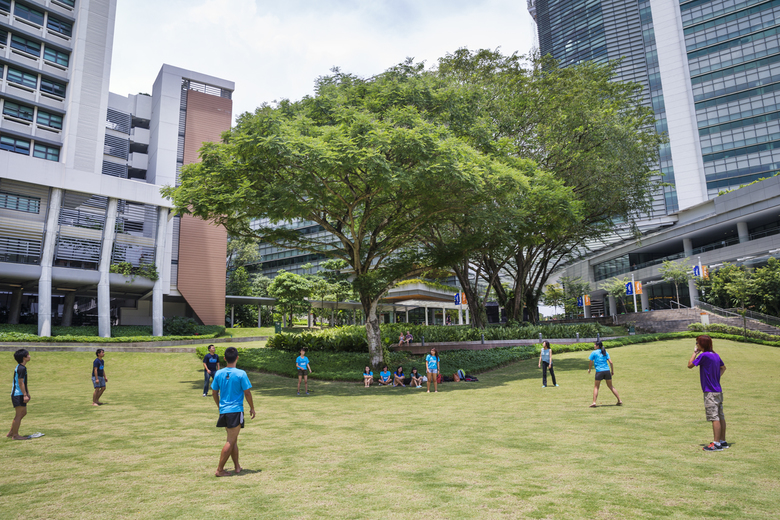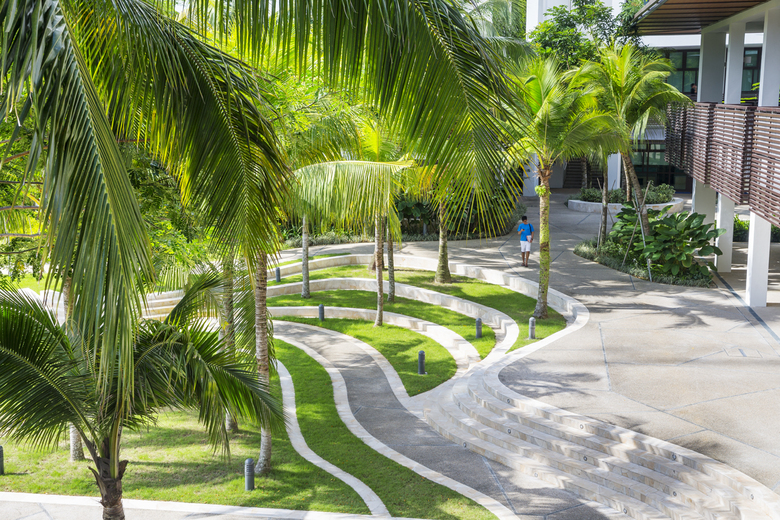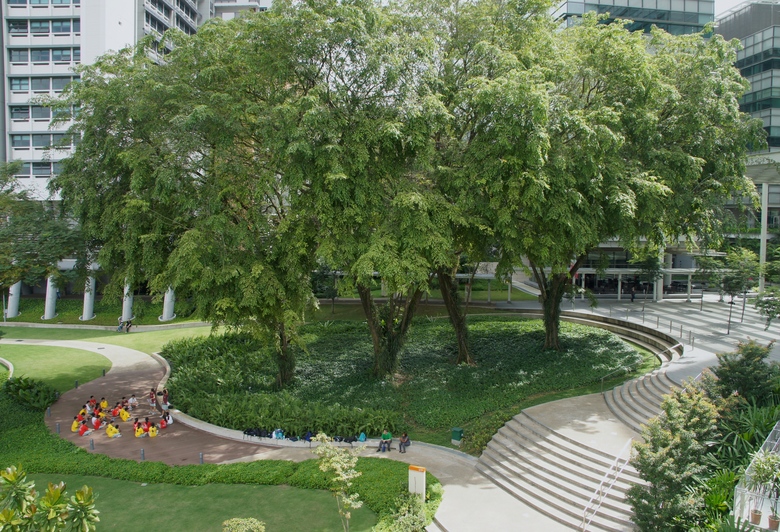NUS University Town (NUS UTown)
Singapore, Singapore
National University of Singapore (NUS) is the oldest university in Singapore. NUS-UT (University Town) was planned as an extension of the main campus at Kent Ridge, physically separated by an expressway with connections via a pedestrian and vehicular bridge.
The NUS-UT site is approximately 19Ha, situated on the grounds of a former golf course with the undulating site topography forming the defining characteristic of the project.
NUS UT is a collection of 6 different projects :- CREATE; Graduate Residences (GR) and Town Green; Cinnamon and Tembusu Residential Colleges (CT); Education Resource Centre (ERC); Khaya and Angsana Residential Colleges (KA); Edu-sports Complex.
The landscape design for NUS-UT is primarily about space and place making while respecting the natural contours of the site. The landscape seeks to create landmarks by simple design enhancements to existing landforms and engagement with existing trees.
"We were inspired by the existing trees. R.W. Emerson once said that the creation of a thousand forests is in one acorn; at NUS University Town, we strived to create a holistic landscape environment capable of "germinating" an appreciation of trees and nature in the thousands of students that would pass through the NUS "acorn" over the years to come”, said Helen-Smith Yeo, Principal & Founder of STX Landscape Architects.
Tree conservation was a major driving force in the planning, design and execution of NUS-UT. Significant mature and exceptional specimen trees in the interiors of the site were carefully integrated into the buildings and landscape layout; existing groves along the periphery were retained for their valuable collective role of buffering the site from other external developments and roads; all of which contributed to the total built environment.
While the majority of the planting is green, to provide individual identities to the various colleges of UT, colour themes associated with the existing trees for which the residential colleges were originally named, have been chosen to guide the choice of flowering and accent plants. The planting strategy for the buffer around UT emphasized sustainability, with preservation of indigenous and existing greenery, and reforestation in bare areas, with 100% Native minimal species types.
Over 2000 new trees and palms were planted on site to augment the 188 existing trees saved from construction. This number excludes those planned for the sky gardens. Rain trees were selected for the Main Dover Road Entrance in order to unite the character of the UT landscape with that of the main NUS Campus. Including green roofs, 48% of the site was set aside for planting and greenery.
UTown Residences
UTown Residences was designed to reflect the advanced and mature nature of the graduate students by creating a more polished and cultured environment, with its own unique identity different from the other colleges.
An environment with graciously designed spaces creates a formality for the project within the larger UT campus context. It’s two towers are connected by a main central atrium landscape courtyard that spans two levels, opening onto the Town Green at the ground level. The upper level of the central atrium courtyard is a drop-off and receiving area for car arrivals and has a reflecting pool which flows down a water wall to the level below for physical and visual connection.
Town Green
The Town Green is the major open space for congregation, active play, supporting high levels of social interaction across campus. Of the 6 major parcels of UT, it anchors 4. The Town Green forms the heart of the campus and with the other parcels make possible a holistic environment for study education and research, side by side with leisure and social living, 24/7.
A natural gathering point pluralistic in design, it generates and celebrates the activities within and around it, melting racial, cultural and nationalistic boundaries. 5 large mature trees preserved and integrated within the Town Green landscape design result in an anchoring counterpoint for the vastness of the bowl-like Green, creating a strong sense of place.
Within a gap between the roots of the last mature tree and the other 4 trees, a timber deck was inserted for users to benefit from the dense shade, as well as being a hiding place for M&E services so that the verdant green surface of the Town Green lawn would be pristine.
Cinnamon and Tembusu Residential Colleges (CT)
Cinnamon and Tembusu Residential Colleges (CT) was intended to embrace the pedagogical shift towards a more intimate, interactive and integrated learning campus experience, relatively new to Asia.
The landscape was designed to create spaces conducive for interactive inter-disciplinary teaching, learning and development of enduring group relationships.
Outdoor areas such as ‘Tembusu Hill and Stage’ were created for groups where site specificity respects and integrates existing contours to inculcate a sense of belonging.
Education Resource Centre (ERC)
As the central focus of UT, the Education Resource Centre (ERC) is situated on a high point where design seamlessly knits the different terrains and boundaries of other parcels.
The ERC building “wraps” the existing Tembusu trees within the embrace of the building. As a primary activity generator for the UT campus, the ERC is 24/7, surrounded with study spaces, e-Café, lecture theatres and computer labs. At ground, the landscape integrates the lower plaza of the e-Café into the green embrace of grass terraces, stepping down to the Town Green, in one grand sinuous sweep.
The ERC has extensive Green Roofs, accentuating an organic yet geometric flow of green platforms slipping and sliding into each other, surrounding the central void from which existing and new trees emerge as a connection to the site.
College of Alice and Peter Tan
Amidst a verdant landscape, the College of Alice and Peter Tan has outdoor spaces crowned by large, ornamental trees, providing shade and relief from the tropical sun.
Reminiscent of an Asian village, this area of UT is distinguished by a design language vernacular in style. This is reinforced through the planting of Coconut Palms ubiquitous with local Asian villages of the past.
An ideal place for quiet contemplation, it exudes a sense of timelessness, while encouraging social and recreational activities. The landscape design makes visible the contours of the site, creating a central signature open space of organic paddy-field” steps, which serves as informal seating spaces, winding through swaying palms.
Stephen Riady Centre
The Stephen Riady Centre has a flexible network of spaces and porous adjacencies for easy transitions between classes and activities. The landscape facilitates this by integrating internal public spaces with the different external landscape spaces surrounding the building.
At ground, an open plaza visually and physically connects the Town Green as an alternate hard-paved gathering and activity space to the Town Green’s verdant lawn.
As part of campus-wide sustainability strategy, vegetation covers the roof of the Centre with vines suspended by steel cables on external walls to minimise heat load.
The resulting landscape of this campus provides graciously designed spaces that accentuate new pedagogic aspirations for intimate, integrated and memorable learning and campus experience. Sequencing of porous and dynamic landscape spaces creates sanctuaries for congregation, recreation, imagination and quiet contemplation.
"The search for design excellence at NUS UT was achieved in rising beyond mundane fundamentals, constraints of architecture and engineering, to result in a landscape that would nurture the basic human need for joy, comfort and a memorable sense of place, in our search of "timeless beauty" which elevates the journey of life”, added Helen-Smith Yeo, Principal & Founder of STX Landscape Architects.
The landscape brings a balanced perspective to design decision making, expanding beyond traditional boundaries to encompass ecology, biodiversity, long-term maintenance strategies and sustainability options, together with aesthetics.
The project received an Award of Excellence at the 11th International Federation of Landscape Architects (IFLA) Asia Pacific Region Awards for Landscape Architecture 2014.
- ランドスケープ アーキテクト
- STX Landscape Architects
- 年
- 2014
- クライエント
- National University of Singapore
- チーム
- C&S Engineers : Beca / T.Y. Lin, M&E Engineers : Beca / WSP PB, Quantity Surveyors : Langdon and Seah / RLB / Faithful+Gould, Sustainability Consultant : ARUP, Arborist : Arborculture, Lighting Consultant : Lighting Planners Associates / iLAB / BSLD / MLS, Main Contractors : Shimizu / KSH Holdings / Guan Ho Construction / Obayashi Corporation, Landscape Contractors : Eco Garden / TEHC / Garden Beau / Nature Landscapes, Lead Landscape Architect (CREATE) : SWA Group (concept and hardscape), Lead Architect (CREATE) : Perkins+Will, Project Manager (CREATE) : JCPL, Façade Consultant (CREATE) : Meindhart, Engineers (CREATE) : ARUP / WSP Lincolne Scott, Master Planning Consultants for NUS-UT : SOM / DPA / STX / BECA / BuroHappold / BSLD / MVA / Acviron
- Architect
- AWP - UTown Residences and Town Green
- Architect
- W Architects - ERC
- Architect
- DPA- College of Alice & Peter Tan, Residential College 4, Cinnamon & Tembusu College and CREATE



















